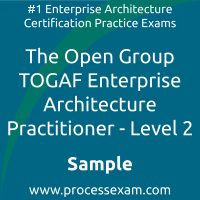01. A retail company is using TOGAF to ensure that its ADM process is well-documented and standardized. Which two components of TOGAF help in standardizing architecture work?
a) Architecture Capability Framework
b) Architecture Repository
c) Customizing ADM Phases Arbitrarily
d) Ignoring Governance Models
02. A global logistics company is defining its Enterprise Architecture requirements as part of a major digital transformation. Which TOGAF ADM process ensures that business requirements remain aligned with architecture development?
a) Phase A – Architecture Vision
b) Requirements Management Process
c) Phase C – Information Systems Architecture
d) Phase G – Implementation Governance
03. Scenario: An organization is transitioning to a TOGAF-based enterprise architecture approach and needs to ensure effective stakeholder engagement. The Chief Architect wants to address concerns regarding the value of TOGAF.
Which two TOGAF benefits should be highlighted to gain stakeholder support?
a) Improved business-IT alignment
b) A rigid, unchangeable enterprise architecture
c) Reduced agility for long-term stability
d) Standardized approach for architecture development
04. A pharmaceutical company is using TOGAF to manage complex enterprise architecture requirements across different departments. Which two key features of Requirements Management help maintain architecture consistency?
a) Ignoring Stakeholder Input
b) Ad-hoc Requirement Changes
c) Iterative Validation of Requirements
d) Centralized Repository for Requirements
05. Scenario: A healthcare organization recently adopted TOGAF and is integrating a new regulatory compliance system. The Chief Architect must ensure that any architectural changes align with existing standards.
Which approach should the Chief Architect use to evaluate and approve changes in TOGAF?
a) Create a new architecture from scratch
b) Use the Architecture Compliance Review process
c) Wait until the next TOGAF cycle to review changes
d) Let individual teams decide on architectural changes
06. A large telecom enterprise is implementing TOGAF and needs a structured way to assess architecture maturity and governance Which two TOGAF components help assess Enterprise Architecture maturity?
a) Avoiding Stakeholder Feedback
b) Architecture Governance Framework
c) Ignoring Architecture Standards
d) Architecture Maturity Models
07. Scenario: A government agency is struggling with fragmented architecture documentation. The Chief Architect wants to use a structured repository to improve architecture governance and reuse.
Which TOGAF resource best supports managing architecture documentation?
a) Architecture Roadmap
b) Business Scenario Analysis
c) Architecture Vision Document
d) Enterprise Architecture Repository
08. A manufacturing company is adopting TOGAF and wants to track architecture decisions throughout the ADM cycle. Which two TOGAF elements provide traceability for architecture decisions?
a) Enterprise Architecture Repository
b) Requirements Management Process
c) Relying on Verbal Discussions
d) Eliminating Documentation Requirements
09. A government agency is implementing its architecture roadmap. The Chief Architect needs to ensure successful execution Which activity is a key focus of Phase G – Implementation Governance?
a) Defining High-Level Business Goals
b) Writing Business Case Documents
c) Monitoring Compliance with Architecture Contracts
d) Selecting Vendors
10. Scenario: An e-commerce company is executing its architecture roadmap. The Chief Architect needs to oversee project execution to ensure alignment with enterprise architecture principles.
Which two TOGAF elements help enforce compliance during implementation?
a) Individual Preferences of Team Members
b) Project Risk Analysis
c) Architecture Governance Framework
d) Architecture Contracts
 You have to pass the OGEA-102 exam to receive the certification from Open Group. To increase the effectiveness of your study and make you familiar with the actual exam pattern, we have prepared this Open Group TOGAF Enterprise Architecture Part 2 sample questions. Our Sample The Open Group TOGAF Enterprise Architecture Part 2 Practice Exam will give you more insight about both the type and the difficulty level of the questions on the Open Group TOGAF Enterprise Architecture Practitioner exam.
You have to pass the OGEA-102 exam to receive the certification from Open Group. To increase the effectiveness of your study and make you familiar with the actual exam pattern, we have prepared this Open Group TOGAF Enterprise Architecture Part 2 sample questions. Our Sample The Open Group TOGAF Enterprise Architecture Part 2 Practice Exam will give you more insight about both the type and the difficulty level of the questions on the Open Group TOGAF Enterprise Architecture Practitioner exam.